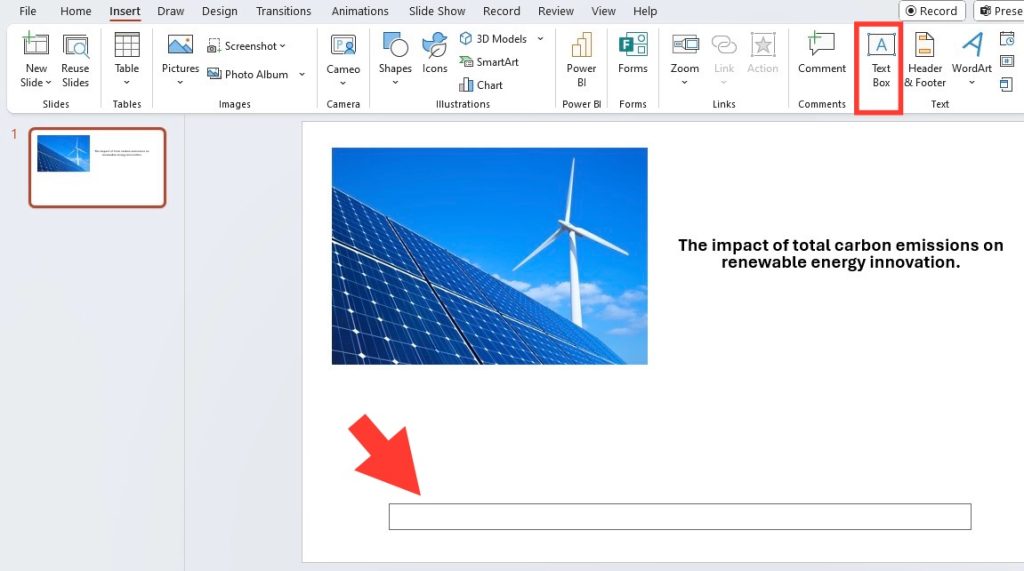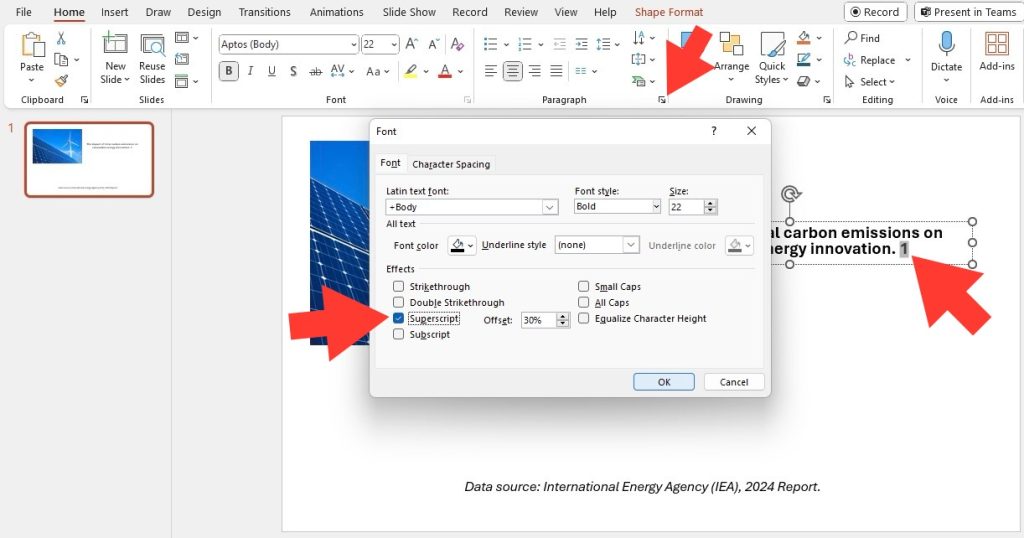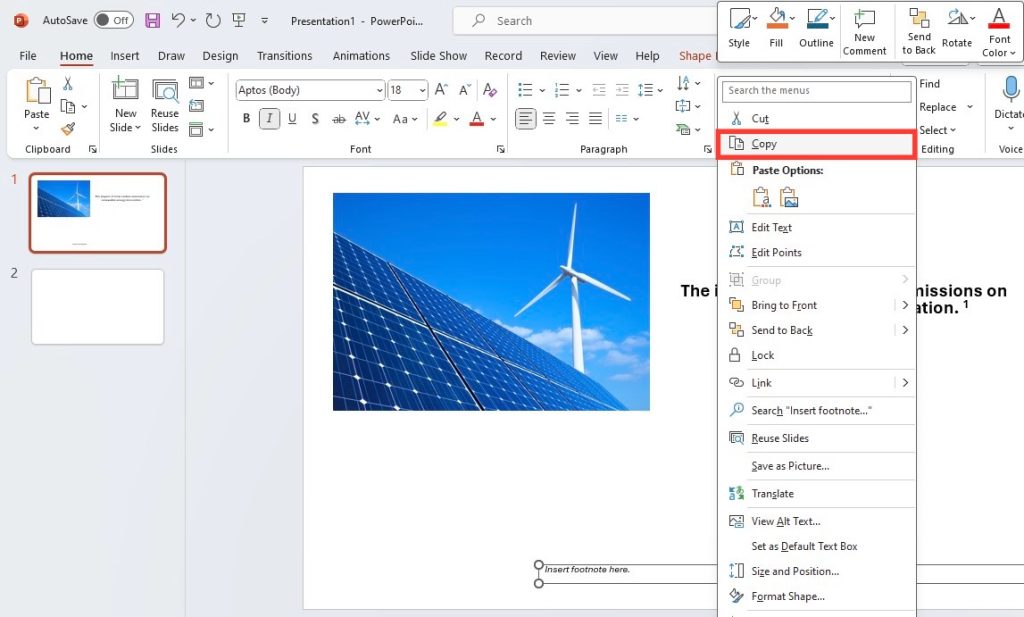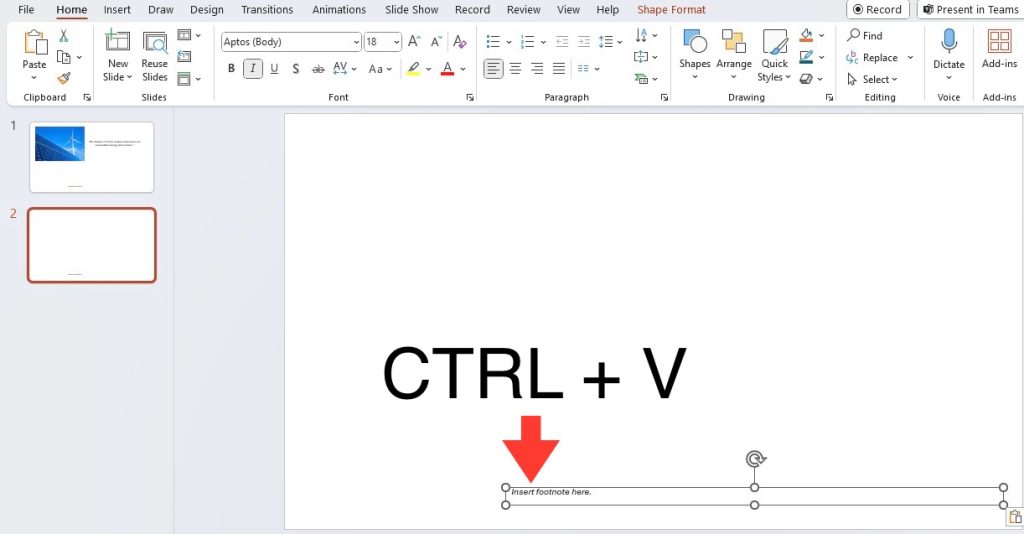Learn about Formulas with our 101 Advanced Excel Formulas & Functions Examples.
Key Takeaways
- To insert footnotes in PowerPoint, select the text box or slide where the footnote will appear, then navigate to the Insert tab to insert a new text box at the bottom.
- Create the footnote annotation by typing a number after the referenced sentence, select the number, and then click on the Superscript option, usually found in the Font section of the menu, to format it appropriately.
- Once the superscripted number is in place, input the detailed information about the footnote in the newly created text box at the bottom of the slide to provide additional context or citations.
Quick overview of PowerPoint’s capabilities for footnotes
PowerPoint offers a genuinely flexible environment for footnotes, accommodating various customizations. They can effortlessly complement your slide’s design with options to alter font size, color, style, and even include hyperlinks or images. These capabilities allow for informative and aesthetically pleasing footnotes that enhance rather than distract from your presentation.
Table of Contents
Step-by-Step Guide to Inserting Footnotes
Step 1: Open your PowerPoint presentation
Kick off by launching Microsoft PowerPoint. Navigate your way to the presentation file you’re working to enrich with footnotes. If you’re starting a new project, that’s fine too! Just open PowerPoint to a fresh, blank presentation and you’re set to insert footnotes as you create your slides.
Step 2: Select the slide and position for your footnote
Next, sift through your slides to find the one that warrants a footnote. Once you’re there, pinpoint where on the slide the footnote will be most effective – usually, this spot is at the base of the slide. With a location in mind, you’re ready to weave informative footnotes into your presentation narrative. Keep in mind the importance of consistency; if you’re footnoting multiple slides, the same spot on each slide is ideal for a professional, tidy look.
Customizing and Formatting Your Footnotes
STEP 1: Create and format the footnote text
To create your footnote, simply head to the ‘Insert’ tab and choose ‘Text Box‘ to place it on the selected slide. Click where you want your footnote to live and type away to add your explanatory note or citation. After inputting the text, bring your footnote to life with formatting flair—adjust the font size to be smaller than your main content, pick a subtle color, and contemplate italicizing the text to differentiate it from the main act above. Remember, the aim is readability and subtlety, so act accordingly!
STEP 2: Tips for maintaining readability and consistency
When it comes to footnotes, clarity is key. Keep the font size legible; slightly smaller than your main text but still big enough to be read without the audience squinting. Choose a clear, sans-serif font and a color that contrasts with the background yet doesn’t shout for attention. To maintain a consistent look, use the same formatting for all footnotes across your presentation.
A pro tip: Save a format template to ensure you don’t have to adjust settings every single time. And keep footnotes concise – they’re aides to your main points, not dissertations on their own.
Advanced Footnote Features
Adding multiple footnotes in a single slide
If your slide is dense with data or references necessitating more than one footnote, fear not—PowerPoint’s got you covered. After creating your first footnote, hit ‘Enter’ for a new line within the same text box, and add the next footnote right beneath. Remember to correspond each new footnote with a superscript number nestled within the slide’s text. This keeps your audience tracking along nicely. Just be cautious—the more footnotes you add, the more essential it is to keep them organized and succinct to maintain your slide’s visual integrity and readability.
Utilizing superscript and special characters
Incorporating superscript numbers or symbols next to the text that corresponds to your footnotes is a breeze. Simply highlight the number or symbol, go to the ‘Font’ group under the ‘Home’ tab, and click on ‘Superscript’ to elevate it. This distinguishes your reference mark from the rest of the text, guiding your audience’s eyes to the additional insights waiting at the slide’s bottom. For a touch of finesse, explore the ‘Symbol’ menu to find special characters if eccentric or industry-specific annotations are your jam.
Maximizing the Impact of Footnotes
Strategic placement for optimal audience engagement
When it comes to inserting footnotes in your presentation, strategic placement is vital for keeping your audience engaged. Place your footnotes at the bottom of the slide, but be mindful of the slide content to ensure they don’t get overlooked. The lower third of the slide is typically where viewers expect to find additional information, so sticking to this unwritten rule can optimize visual flow and comprehension. The key here is to enhance the experience, not hinder it with cluttered or hard-to-find information.
Incorporating footnotes into presentation design effectively
Melding footnotes with your PowerPoint design demands a judicious balance between visibility and subtlety. Your footnotes should harmonize with the theme and palette of your slides—think of them as the cherry on top that shouldn’t overshadow the sundae. Use a discrete but coherent design that aligns with the fonts, colors, and overall style of your slides. This integration not only amplifies professionalism but also solidifies your brand’s visual identity throughout the presentation. Remember, effective footnotes are like whispers adding depth to your story—they should be felt more than they are heard.
Troubleshooting Common Footnote Challenges
Removing or editing existing footnotes
To edit or remove an existing footnote, simply click on the text box containing the footnote to enter edit mode. Make your desired changes directly in the text box. If you decide a footnote is no longer necessary, select the footnote text and hit ‘Delete’ on your keyboard. If you remove a footnote, don’t forget to also remove any corresponding reference in the slide’s text to maintain clarity and avoid confusion. For a clean sweep, check that all footnotes have been updated by the time you’re ready to present.
Reusing footnotes across different presentations
Reusing footnotes can be a timesaver, especially if you frequently present on similar topics. PowerPoint doesn’t have a built-in feature for reusing footnotes, but you can cleverly replicate them. Once you’ve perfected a footnote style, copy the text box and paste it into a new slide as needed, updating the content for each specific case. Alternatively, keep a template slide with predefined footnote placeholders and copy this slide into new presentations, ensuring uniformity with minimal fuss.
For a more dynamic approach, PowerPoint add-ins like PPT Productivity can enhance your workflow. These tools often have features such as a Slide Library, where you can save a footnote style and effortlessly inject it into new presentations with just a few clicks. They help ensure each footnote looks consistently professional across all your slides and presentations.
To save a footnote style, follow these steps:
STEP 1: Select the Footnote text box.
STEP 2: Delete the current text and replace it with a placeholder like “XXX” or “Insert footnote here”.
STEP 3: Copy the text box by right-clicking and hitting Copy. Or simply CTRL+C.
STEP 4: Use the copied style in future slides by pasting it. CTRL+V.
Leveraging Technology for Enhanced Presentations
Using add-ins and software for efficient footnote addition
For the tech-savvy presenters looking to streamline their experience, using add-ins or specialized software can be a game changer. These tools often provide features that can simplify the process of adding footnotes. For instance, UpSlide’s Footnotes feature allows you to seamlessly integrate and manage footnotes within PowerPoint. With customizable formatting options, you no longer have to manually adjust each footnote, saving you valuable time and ensuring consistency throughout your presentation. This can be particularly useful if your presentation requires frequent citation updates or collaboration among multiple editors.
Additionally, these tools may offer enhanced functionality, like automatic numbering, dynamic updating of footnotes, and the capability to import citations directly from external databases, thereby enhancing the quality and accuracy of your presentations.
When selecting a tool or add-in, consider these features:
- Ease of use and integration with PowerPoint
- Customization options for style and formatting
- Time-saving features like auto-numbering and dynamic updates
- Compatibility with citation management software
Keep in mind that these external tools may come with costs or require a learning curve, so weigh the benefits against your needs and resources.
Converting external content into footnoted PowerPoint slides
Converting external content into footnoted PowerPoint slides can be particularly handy when you’re dealing with extensive research or data that originates from various sources. Tools such as OneNote or reference management software like Zotero and EndNote can be pivotal in streamlining this process.
To incorporate footnotes from external content into your slides, follow a methodical process:
- Use reference management software to organize and store all citations.
- Export the references into a format compatible with PowerPoint.
- Copy the formatted citations and paste them directly into your slide as footnotes.
For a direct approach, some software solutions can integrate seamlessly with PowerPoint, allowing you to insert citations as footnotes with a few clicks, automatically formatting them according to your selected style.
Remember, when converting external content, ensure attributions are correct and consistent with your presentation’s style and citation format. This approach should reinforce the credibility of your presentation without compromising the design or the flow of information.
Frequently Asked Questions (FAQs) on How to Add a Footnote in PowerPoint
What are the benefits of adding footnotes in a PowerPoint presentation?
Footnotes enrich your PowerPoint presentation by providing additional context, supporting data, or citations without overcrowding your slides. They help maintain a clean design while also offering a way to validate your claims and improve credibility.
How can I ensure my footnotes are easily readable during a presentation?
To ensure footnotes are readable, use a clear font, contrast color, and size that’s smaller than the main text but still legible. Place them consistently at the bottom of each slide.
Can I save a footnote format to use in future presentations?
Yes, create a footnote template in PowerPoint or use add-ins with features like Slide Libraries to save and reuse formats across presentations.
Is there a way to automatically insert footnotes when importing content into PowerPoint?
Automatic footnote insertion isn’t a built-in PowerPoint feature. However, reference management tools and add-ins may facilitate this during import.
John Michaloudis is a former accountant and finance analyst at General Electric, a Microsoft MVP since 2020, an Amazon #1 bestselling author of 4 Microsoft Excel books and teacher of Microsoft Excel & Office over at his flagship MyExcelOnline Academy Online Course.












